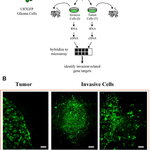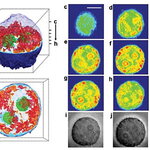Cancer Research

A prominent problem in AIDS is a form of dementia that robs one’s ability to concentrate and perform normal movements. Scientists at the Burnham Institute for Medical Research (Burnham) have discovered how HIV/AIDS disrupts the normal replication of stem cells in the adult brain, preventing new nerve cells from forming.
Drs. Stuart Lipton, Marcus Kaul, Shu-ichi Okamoto and their colleagues uncovered a novel molecular mechanism that inhibits stem cell proliferation and that could possibly be triggered in other neurodegenerative diseases as well.
A normally functioning adult human brain has…

Mayo Clinic researchers have identified the first immune molecule that appears to play a role in prostate cancer development and in predicting cancer recurrence and progression after surgery. The report on the B7-H3 molecule by Mayo Clinic Cancer Center appears today in Cancer Research.
“This discovery will allow physicians to individualize treatment and observation plans for prostate cancer patients,” says Timothy Roth, M.D., a Mayo Clinic urology resident and lead author of the study. “Being able to tell a patient his specific risk after surgery, and perhaps even prior to surgery, will be a…

Metforin, the most commonly prescribed diabetes drug, kills tumor cells that lack key regulatory gene p53, according to a new study by researchers at the University of Pennsylvania School of Medicinr.
More than half of all human cancers have lost the p53 gene. Yet even in an era of molecularly targeted therapies scientists have had trouble figuring out how to compensate for the absence of a gene. Unlike a genetic mutation that changes the function or activity of a gene, which can be inhibited by a well-tailored drug, loss of a gene leaves nothing for the drug to target.
“This is the first…

The invasive nature of cancers in general, and malignant gliomas in particular, is a major clinical problem rendering tumors incurable by conventional therapies.
Using a novel invasive glioma mouse model established by serial in vivo selection, new research has identified the p75 neurotrophin receptor (p75NTR) as a critical regulator of glioma invasion. Through a series of functional, biochemical, and clinical studies, it was found that p75NTR dramatically enhanced migration and invasion of genetically distinct glioma and frequently exhibited robust expression in highly invasive glioblastoma…

A major surprise emerging from genome sequencing projects is that humans have a comparable number of protein-coding genes as significantly less complex organisms such as the minute nematode worm Caenorhabditis elegans. Clearly something other than gene count is behind the genetic differences between simpler and more complex life forms.
Increased functional and cellular complexity can be explained, in large part, by how genes and the products of genes are regulated. A University of Toronto-led study reveals that a step in gene expression (referred to as alternative splicing) is more highly…

Two new studies may lead to the development of more effective therapies for individuals with multiple myeloma (MM), a common and incurable blood cell cancer. The research provides new insight into the molecular mechanisms that underlie aberrant NF-κB activity in MM tumor cells and underscores the relevance of the NF-κB signaling pathway as a target for MM therapy.
MM is a cancer of the plasma cell, a blood cell that produces antibodies to help the body fight off infections. Previous research implicates abnormal activation of the NF-κB signaling pathway as a key event in MM pathology. NF-κB…

Robert Weinberg, MIT professor of biology and Whitehead Institute for Biomedical Research member, has created cancer stem cells in a Petri dish by isolating and transforming a particular population of cells from human breast tissue. After being injected with just 100 of these transformed cells, mice developed tumors that metastasized (spread to distant tissues).
“The operational definition of a cancer stem cell is the ability to initiate a tumor, so these are cancer stem cells,” declares Weinberg, who is also an MIT professor of biology.
Engineering these potent cells was not the original…

A new imaging technique developed at MIT has allowed scientists to create the first 3D images of a living cell, using a method similar to the X-ray CT scans doctors use to see inside the body.
The technique, described in a paper published in the Aug. 12 online edition of Nature Methods, could be used to produce the most detailed images yet of what goes on inside a living cell without the help of fluorescent markers or other externally added contrast agents, said Michael Feld, director of MIT's George R. Harrison Spectroscopy Laboratory and a professor of physics.
"Accomplishing this has been…

Scientists at Keele University in Staffordshire have questioned the safety of aluminium added to sunscreens and sunblocks.
The researchers, Scott Nicholson and Dr. Christopher Exley, measured the aluminium content of sunscreens/sunblocks, which either include or do not include an aluminium salt (for example, aluminium hydroxide, aluminium oxide, aluminium silicate, aluminium stearate, aluminium starch octenylsuccinate) as an ingredient.
Aluminium was present in all seven products tested and its content was of particular significance in three products, each of which listed it as an ingredient…

When molecular disaster strikes, causing structural damage to DNA, players in two important pathways talk to each other to help contain the wreckage, scientists at The University of Texas M. D. Anderson Cancer Center report in the August edition of Cell.
This connection between a signaling pathway crucial to DNA damage control and a pathway known as chromatin remodeling "opens an entirely new category of targets for potentially attacking cancer," says senior author Xuetong "Snow" Shen, Ph.D., an assistant professor in M. D. Anderson's Department of Carcinogenesis at the Science Park -…